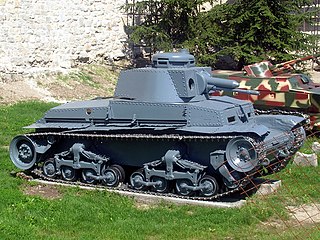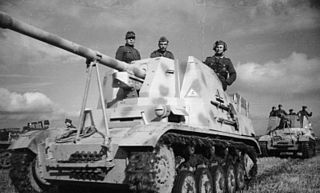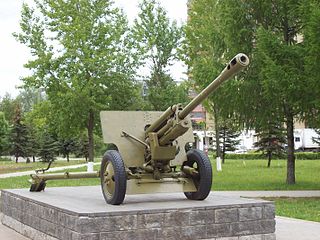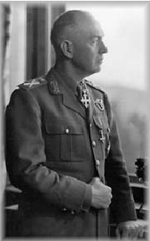
A tank destroyer, tank hunter, tank killer, or self-propelled anti-tank gun is a type of armoured fighting vehicle, armed with a direct fire artillery gun or missile launcher, designed specifically to engage and destroy enemy tanks, often with limited operational capacities.

The Jagdpanzer 38, originally the Leichter Panzerjäger 38(t), known mostly post-war as Hetzer, was a German light tank destroyer of the Second World War based on a modified Czechoslovakian Panzer 38(t) chassis.

The Panzerkampfwagen 35(t), commonly shortened to Panzer 35(t) or abbreviated as Pz.Kpfw. 35(t), was a Czechoslovak-designed light tank used mainly by Nazi Germany during World War II. The letter (t) stood for tschechisch (German for "Czech"). In Czechoslovak service, it had the formal designation Lehký tank vzor 35 (Light Tank Model 35), but was commonly referred to as the LT vz. 35 or LT-35.

Hummel was a German self-propelled gun used by the Wehrmacht during the World War II. Based on the Geschützwagen III/IV chassis and armed with the 15 cm sFH 18/1 L/30 howitzer, it saw action from early 1943 until the end of the war. Its ordnance inventory designation was Sd.Kfz. 165.

The Marder II was a German tank destroyer of World War II based on the Panzer II chassis. There were two versions, the first mounted a modified Soviet 7.62 cm gun firing German ammunition, while the other mounted the German 7.5 cm Pak 40 gun. Its high profile and thin open-topped armor provided minimal protection to the crew. Nevertheless, the Marder II provided a great increase in firepower over contemporary German tanks during 1942 and into 1943. Only four Marder IIs remain today.

The Turán tanks were a series of Hungarian medium tanks of World War II. They were produced in two main variants: the original 40M Turán with a 40 mm gun and later the 41M Turán with a short-barreled 75 mm gun, improved armour and a new turret. A total of 424 were made. The 40M Turán was originally inspired by and used the technology-based solutions found on the design of the Czechoslovak Škoda T-21 medium tank prototype. The Turán tanks fought on the Eastern Front against the Soviets, and in the defence of Hungary.

The 76-mm divisional gun M1942 (ZiS-3) was a Soviet 76.2 mm divisional field gun used during World War II. ZiS was a factory designation and stood for Zavod imeni Stalina, the honorific title of Artillery Factory No. 92, which first constructed this gun.

T-20 armored tractor Komsomolets(Bronirovannyy gusenichnyy tyagach Komsomolets T-20), an armored continuous track tractor, the T-20 was a prime mover vehicle used by the Soviet Union during the Winter War and World War II.

The T-34 medium tank is one of the most-produced and longest-lived tanks of all time.

Tanks were an important weapons system in World War II. Even though tanks in the inter-war years were the subject of widespread research, production was limited to relatively small numbers in a few countries. However, during World War II, most armies employed tanks, and production levels reached thousands each month. Tank usage, doctrine and production varied widely among the combatant nations. By war's end, a consensus was emerging regarding tank doctrine and design.

The Mareșal, also known as the M-tank, was a Romanian-produced light tank destroyer from World War II. Romania was a member of the Axis powers and created the vehicle in response to the Soviet T-34 and KV-1 tanks. It is credited with having inspired the German Hetzer's design, according to multiple German military staff.

The TACAM R-2 was a Romanian tank destroyer used during World War II. It was built by removing the turret of the R-2 light tank and building a pedestal to mount a Soviet 76.2 mm (3.00 in) ZiS-3 field gun in its place. A three-sided fighting compartment was built to protect the gun and its crew. Twenty were built in 1944, but only one is known to exist today. It participated in the Budapest Offensive and the Prague Offensive.

The 75 mm Reșița Model 1943 was an anti-tank gun produced by Romania during World War II. It combined features from the Soviet ZiS-3 field/anti-tank gun, the German PaK 40 and the Romanian 75 mm Vickers/Reșița Model 1936 anti-aircraft gun. It saw service against both the Soviets during the Jassy-Kishniev Offensive and against the Germans during the Budapest Offensive and subsequent operations to clear Austria and Czechoslovakia.

The TACAM T-60 was a Romanian tank destroyer used during World War II. It was built by removing the turret of captured Soviet T-60 light tanks and building a pedestal to mount a captured Soviet 76.2 mm (3.00 in) M-1936 F-22 field gun in its place. A three-sided fighting compartment was built to protect the gun and its crew. Thirty-four were built in 1943, and they served in the Jassy-Kishniev Offensive, and the Budapest Offensive.

The TACAM R-1 was a small tank destroyer for use by Romania during World War II. It was designed on 22 November 1943 at the request of the Romanian General Staff. Fourteen R-1 vehicles were to be rearmed with 45 mm 20-K guns. Although this vehicle was designed to be used only for security duties, the project was cancelled because it was eventually regarded as a waste of badly needed industrial capacity, the 45 mm gun having been obsolete against most Soviet tanks by then.

The TACAM T-38 was a tank destroyer design proposed to be built in Romania during World War II. It was supposed to be a successor of the similar TACAM R-2, but never entered production.

The T-1 tractor was a project developed by the Romanian Army during World War II. A total of 1,000 were ordered. It was designed to tow a Romanian 75 mm gun. After five prototypes were produced, the project was canceled due to the lack of priority.

R-3 was a proposed Romanian tank design for use in World War II. It was basically a variant of the Czechoslovak S-II-c tank prototype which was going to be built in Romania because of the repeated acquisition failures. Because of political reasons and the limited industrial capacities of both Škoda Works and the Romanian industry, the design never entered production.
During the Second World War, the Kingdom of Romania produced, converted or significantly improved a variety of armored fighting vehicles, ranging from licence-built unarmed artillery tractors to tank destroyers of an original design which ended up - according to some accounts - as inspiration for some German AFV.

The R-1 was a Romanian-used tank that saw action during World War II within the mechanized Romanian cavalry. It was a modified version of the AH-IV, a Czechoslovak-designed export vehicle, which was used exclusively by Romanian forces during the war. A number of 36 were used, 35 of which were built in Czechoslovakia, while one modified example was built in Romania under license. The R-1 is classified as either a light tank or tankette.



















